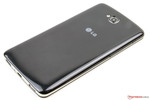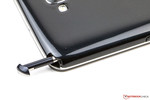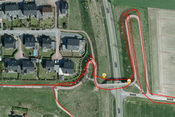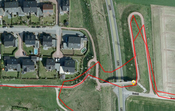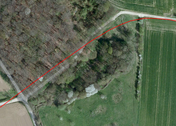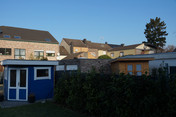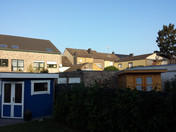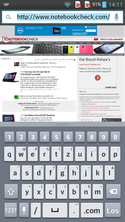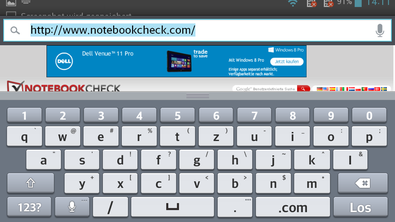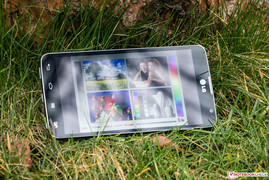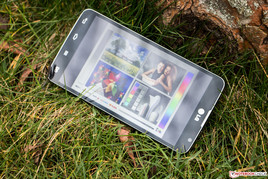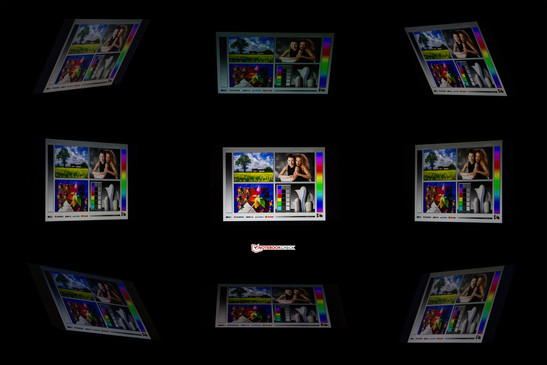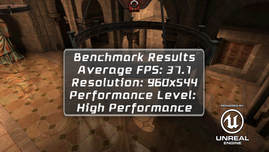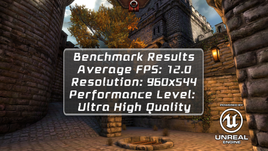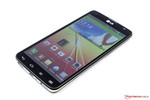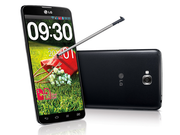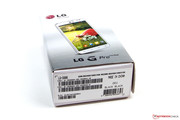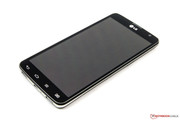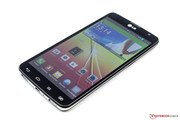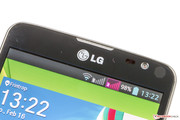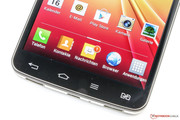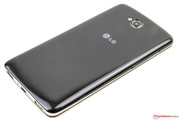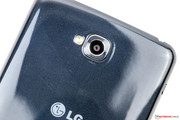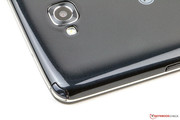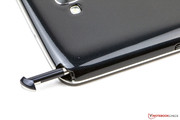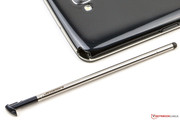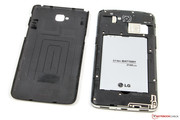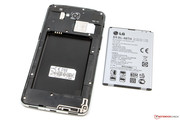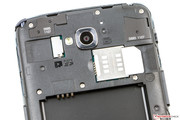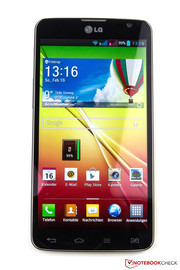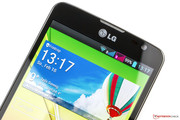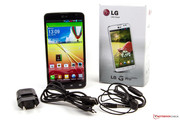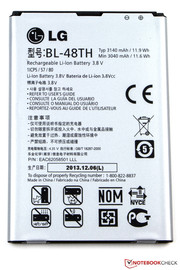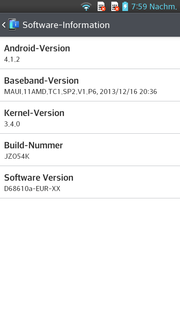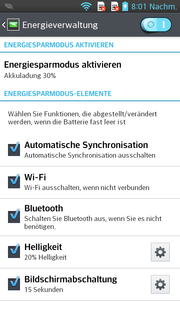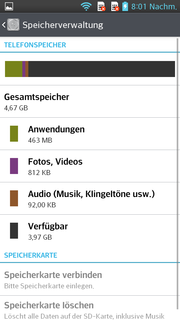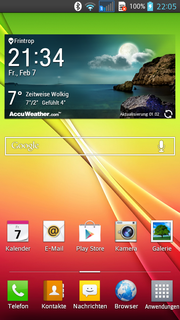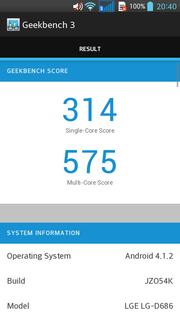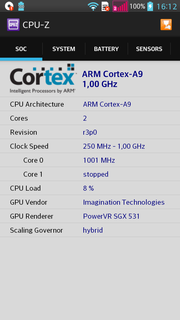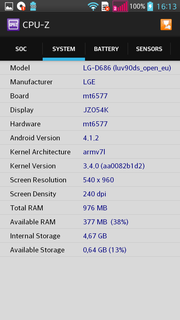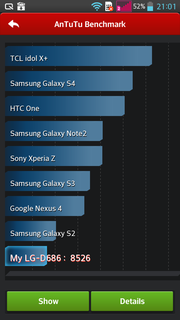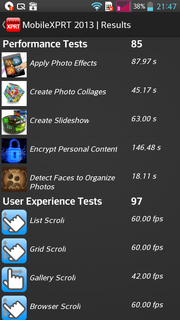Review LG G Pro Lite Dual D686 Smartphone

For the original German review, see here.
The Asia-based company offers a large smartphone dubbed LG G Pro Lite Dual D686. It features a screen size of 5.5-inches, and the South Korean manufacturer calls it a "phablet". Unfortunately, the screen has a comparatively low resolution of only 960x540 pixels. The installed MediaTek MT6577 processor has two cores that clock with 1.0 GHz each. These specs would actually place the device in the entry-level category, but the working memory of 1024 MB and flash storage of 8 GB are a bit too big for that. The RRP of approx. 349 Euros (~$479) is somewhat steep, particularly seeing that the competition partly offers much stronger configurations for the same money. Even older premium models are available for this price.
Direct dual-SIM contenders are found in Acer's Liquid S1 (from 280 Euros, ~$384), and Huawei's Ascend G700 (from 195 Euros, ~$267). However, other smartphones with only one SIM slot are also within this price range. Among others, there is the Nokia's Lumia 1320 (from 300 Euros, ~$412), Asus' Fonepad Note 6 (from 320 Euros, ~$439), and Samsung's Galaxy Note 2 (from 346 Euros, ~$475). Even the bigger LG G Pro E986 features better equipment, and is available for a price starting at 388 Euros (~$533).
Case
The casing of LG's G Pro Lite Dual is completely made of plastic. However, it makes a high-quality impression throughout owing to its stability and weight. The smartphone is almost as big as the higher class G Pro E986 (172 g) model, but it is not quite as heavy with just 163 grams. The back features an unobtrusive pattern that looks like denim on closer examination. This dark blue color impression is reinforced in bright light. However, its surface is sleek, and also unfortunately very susceptible to fingerprints.
The build quality is really good. The gaps are even, and everything fits accurately. Besides that, the device proves to be very stiff; the Pro Lite only makes a quiet creaking noise. Applying pressure to the device's back or narrow display bezel remains without consequences.
Although the stylus inserted into the phablet fits tightly in its compartment, it is easy to take out. A small notch on the right allows the simple opening of the casing's back to access the battery, memory card slot, and mini-SIM slots. The cover is easy to put on again and stays firmly in place. All in all, the review sample makes a good impression.
Connectivity
The USB 2.0 port is located on the bottom edge of LG's G Pro Lite Dual. It is used for both recharging the device and data sharing with a computer. Unfortunately, the port does not support either MHL for image transmission or OTG for connecting the device with an external storage or an input device.
The smartphone can be used as a remote for a TV set, Blu-ray player or stereo system in connection with the app Quick Remote and the infrared sensor.
The phablet's storage capacity can be expanded up to 32 GB (SDHC) via the integrated micro-SD slot.
Software
The operating system installed is Google's Android 4.1.2 Jelly Bean. We would have liked to see a somewhat newer version here. LG overlays it with its own Fluid UI that looks quite colorful.
The South Korean manufacturer does not install any bloatware. Only Google apps and Polaris Viewer are pre-loaded. The other applications are in-house developments. Among them we find Quick Remote, SmartWorld, LG Backup, Quick Translator, RemoteCall Service and Smart Share.
Communication & GPS
LG's G Pro Lite Dual has a Wi-Fi module that supports the IEEE 802.11 b/g/n standards, and thus transmits in the 2.4 GHz band. Reception was still good even at a distance of 20 meters with only a few obstacles. However, 15 meters from the router (Fritz!Box 6360) at most is possible indoors. Although there is still a signal, timeouts occur even while websites are loading.
Although the smartphone does not feature LTE as a mobile wireless connection option, its UMTS/HSPA frequency coverage is quite good. However, the maximum bandwidth is limited to 7.2 MBit/s in download and 5.76 MBit/s in upload. This should, however, be sufficient for most needs. Bluetooth 3.0 is also installed.
The integrated GPS receiver made a mixed impression. The GPS Fix failed even outdoors using the app GPS Test. We were ultimately localized correctly in our tracking test, but the accuracy was unsatisfactory compared with the Garmin Edge 500.
Telephony & Speech Quality
The telephone app's layout is clearly arranged. It is possible to drag a minimized input field to the left or right for facilitating one-handed use. The dual-SIM feature is easy to manage. The settings can be accessed over the dedicated button under the screen. Only the first mini-SIM slot can set up a data connection; the second is for telephony.
The speech quality of LG's G Pro Lite Dual is rather middling. The called party is well-intelligible when the smartphone is held to the cheek, and only high pitches sound piercing. Unfortunately, the user hears a permanent noise, and sometimes sounds a bit distorted. In addition, speech dropouts occur when the speaker is used at a distance of almost 20 centimeters. The included headset does not make a particularly high quality impression but has the best speech acoustics in the comparison. The proximity sensor works flawlessly.
Cameras & Multimedia
LG's G Pro Lite Dual sports two cameras. The front-facing webcam has a resolution of 1.3 MP (1280x720 pixels) and is suitable for video calls. Pictures look quite bright, but they are very faded.
The primary camera has a resolution of 8 MP (3264x2448 pixels in 4:3; 3264x1836 pixels in 16:9). The system also features a voice shutter release that shoots a picture when a few words are spoken. This worked quite well in practical use and can also be used as a remote shutter release. The maximum possible photosensitivity of ISO 400 already indicates that pictures should best be taken in daylight or bright surroundings. The integrated LED flash is quite useful in short ranges, and brightens up the picture, which does not look really focused anyway. The camera's performance is middling even in daylight. Although snapshots are throughout possible, the shots always look a bit faded when looking closer. In particular, clear outlines fray easily. Videos can only be recorded in 720p (1280x720 pixels).
Accessories
LG's G Pro Lite Dual comes with a USB cord for both recharging the smartphone and data sharing with a computer. The modular power supply has an output power of 6 watts (5.0 watts; 1.2 amperes). A quick-start guide and a headset are also included.
The manufacturer has no optional accessories. However, LG offers universal accessories for its mobile end products, e.g. a portable photo printer (from 99 Euros, ~$136) or external secondary batteries (from 30 Euros, ~$41).
Warranty
The South Korean manufacturer includes a 24 month warranty on its product. The battery is only covered for six months. There are no upgrades available.
Input Devices & Controls
The capacitive touchscreen in LG's G Pro Lite Dual detects up to ten simultaneous points. The screen's swiping capabilities are good, and inputs are detected reliably and implemented accurately even at the edges.
Four touch buttons are located below the screen. In addition to the three standard Android buttons, there is another that leads directly to the operating system's SIM card manager. Unfortunately, the buttons do not provide a palpable feedback so that impatient users will feel the urge to press it again during short loading times.
The virtual keyboard is well-conceived and uses the available space adequately. Particularly the additional number bar is appealing. A lot of content remains visible on the screen in portrait mode - without affecting the input quality. Nevertheless, landscape mode is more suitable for longer texts although not much of the displayed content is visible.
The integrated stylus fits tightly into its compartment. Along with the app Quick Memo, it enables making handwritten notes that are quickly saved and shared. Stylus inputs are accurate, and the system implements them swiftly. It can even be used for the touch buttons below the screen.
Display
The screen in LG's G Pro Lite Dual has a size of 5.5-inches, and a resolution of 960x540 pixels. That corresponds to an aspect ratio of 16:9, and a pixel density of only just 200 ppi. That is much too low in view of the price range, and does not really fit to the screen size. The fonts' outlines look pixelated on closer examination. A resolution of at least 1280x720 pixels would certainly have been appropriate here, as used in both the Ascend G700 and Liquid S1. The Chinese iOcean X7 phone even features a Full HD screen (1920x1080 pixels).
The maximum brightness of 438 cd/m² is on a good level. Unfortunately, the illumination is rather middling. However, this is not noticed in normal use.
| |||||||||||||||||||||||||
Brightness Distribution: 79 %
Center on Battery: 409 cd/m²
Contrast: 1278:1 (Black: 0.32 cd/m²)
ΔE ColorChecker Calman: 5.13 | ∀{0.5-29.43 Ø4.77}
ΔE Greyscale Calman: 5.16 | ∀{0.09-98 Ø5}
Gamma: 2.34
CCT: 7090 K
The black level of LG's G Pro Lite Dual is comparatively good with 0.32 cd/m². Both Acer's Liquid S1 (0.63 cd/m², 686:1) and Huawei's Ascend G700 (0.7 cd/m², 803:1) supply poorer rates. The contrast of 1278:1 is also great.
The color accuracy of the installed screen is decent. However, practiced eyes will notice deviations. Both the mixed colors and the grayscale range in an area of dE 5. Only the screen's light greenish cast is annoying but will barely be noticed in everyday use. This criticism is on a high level considering the price range though.
LG's G Pro Lite Dual is impressive in outdoor use. This is particularly due to its bright and high-contrast screen. However, the reflective surface quickly ruins the fun in bright sunlight, but the content remains well-legible in most situations.
The viewing angles of LG's G Pro Lite Dual are good owing to the underlying IPS technology, and even allow extremely flat viewing angles. A minor brightness loss is noticed in more acute angles. Also, a kind of ghosting effect of the displayed content turns up at about 100 degrees. This is because there is too much room between the screen's cover and the display. Nevertheless, the Pro Lite is overall convincing here.
Performance
LG's G Pro Lite Dual is powered by a MediaTek MT6577 processor. It features two processing cores that clock with 1.0 GHz each. The SoC is supported by 1 GB of working memory and the PowerVR SGX531 graphics unit. Thus, the performance is more in the entry-level category, and can be classified as weak in the comparison field. The Liquid S1 (MT6589, 1.5 GHz), the Ascend G700 (MT6589, 1.2 GHz), and the iOcean X7 (MT6589, 1.2 GHz) all use faster quad-core SoCs.
The performance difference becomes very obvious in the benchmarks. The review sample is the taillight in almost all sectors. The contenders benefit from both the higher clock rate and twice as many CPU cores, and do not give the weak SoC in the Pro Lite a chance.
| Geekbench 2 - 32 Bit - Total Score (sort by value) | |
| LG Optimus G Pro Lite Dual D686 | |
| Huawei Ascend G700 | |
| iOcean X7 | |
| Asus Fonepad Note FHD 6 ME560CG (K00G) | |
| Huawei Ascend Mate | |
| Acer Liquid S1 | |
| GFXBench (DX / GLBenchmark) 2.7 | |
| 1920x1080 T-Rex Offscreen (sort by value) | |
| Huawei Ascend G700 | |
| iOcean X7 | |
| Asus Fonepad Note FHD 6 ME560CG (K00G) | |
| Huawei Ascend Mate | |
| Acer Liquid S1 | |
| T-Rex Onscreen (sort by value) | |
| Huawei Ascend G700 | |
| iOcean X7 | |
| Asus Fonepad Note FHD 6 ME560CG (K00G) | |
| Huawei Ascend Mate | |
| Acer Liquid S1 | |
| 3DMark | |
| 1280x720 Ice Storm Standard Score (sort by value) | |
| LG Optimus G Pro Lite Dual D686 | |
| Huawei Ascend G700 | |
| Asus Fonepad Note FHD 6 ME560CG (K00G) | |
| Huawei Ascend Mate | |
| Acer Liquid S1 | |
| 1280x720 Ice Storm Standard Graphics (sort by value) | |
| LG Optimus G Pro Lite Dual D686 | |
| Huawei Ascend G700 | |
| Asus Fonepad Note FHD 6 ME560CG (K00G) | |
| Huawei Ascend Mate | |
| Acer Liquid S1 | |
| 1280x720 Ice Storm Standard Physics (sort by value) | |
| LG Optimus G Pro Lite Dual D686 | |
| Huawei Ascend G700 | |
| Asus Fonepad Note FHD 6 ME560CG (K00G) | |
| Huawei Ascend Mate | |
| Acer Liquid S1 | |
The performance differences are not quite as extreme in the browser benchmarks because the software is particularly decisive here. Alongside Google's Chrome 32, LG's G Pro Lite Dual reaps in quite decent scores, and is especially convincing in Octane V1. The browsing speed is good in practical use, and does not give reason for complaint.
| Peacekeeper - --- (sort by value) | |
| LG Optimus G Pro Lite Dual D686 | |
| Huawei Ascend Mate | |
| Huawei Ascend G700 | |
| iOcean X7 | |
| Acer Liquid S1 | |
| Asus Fonepad Note FHD 6 ME560CG (K00G) | |
| Octane V1 - Total Score (sort by value) | |
| LG Optimus G Pro Lite Dual D686 | |
| Huawei Ascend Mate | |
| Huawei Ascend G700 | |
| iOcean X7 | |
| Acer Liquid S1 | |
| Asus Fonepad Note FHD 6 ME560CG (K00G) | |
| Browsermark - --- (sort by value) | |
| LG Optimus G Pro Lite Dual D686 | |
| Huawei Ascend G700 | |
| iOcean X7 | |
| Acer Liquid S1 | |
| Asus Fonepad Note FHD 6 ME560CG (K00G) | |
| Sunspider - 1.0 Total Score (sort by value) | |
| LG Optimus G Pro Lite Dual D686 | |
| Huawei Ascend Mate | |
| Huawei Ascend G700 | |
| iOcean X7 | |
| Acer Liquid S1 | |
| Asus Fonepad Note FHD 6 ME560CG (K00G) | |
* ... smaller is better
Storage Devices
LG's G Pro Lite Dual sports an 8 GB flash storage. Only about 4.7 GB is available after the initial start. The storage can be expanded via the micro-SD slot should this not be enough.
Particularly the write speed is the storage's strength. The smartphone is sometimes even better than the Asus Fonepad here. The rates in reading data are unfortunately not as good; these are notably decisive for launching apps. The Ascend G700 is as much as twice as fast.
Games
The PowerVR SGX531 is crucial for the gaming performance of LG's G Pro Lite Dual. However, its best years are gone. The available performance is nevertheless enough for most games in Google's Play Store. Current 3D hits could occasionally stutter or refuse to start though.
The touchscreen and sensors function reliably, and provide a good gaming experience.
Emissions
Temperature
The idle surface temperatures of LG's G Pro Lite Dual are low, and always stay below 30 °C. We ascertained the maximum temperature development on the smartphone's casing using the app Stability Test. The application loads both the processor and the graphics card for two hours. The temperatures climbed up to 39.5 °C in this scenario, which is relatively high. All contenders remained below this rate although they sport stronger hardware. Huawei's Ascend G700 is the coolest device in the comparison field (max. 34.5 °C). Nevertheless, the review sample's temperature is not concerning, and will barely ever occur in practical use.
(+) The maximum temperature on the upper side is 39.1 °C / 102 F, compared to the average of 35.2 °C / 95 F, ranging from 21.9 to 247 °C for the class Smartphone.
(+) The bottom heats up to a maximum of 39.5 °C / 103 F, compared to the average of 34 °C / 93 F
(+) In idle usage, the average temperature for the upper side is 27 °C / 81 F, compared to the device average of 32.9 °C / 91 F.
Speakers
LG's G Pro Lite Dual sports two stereo speakers that neighbor the USB port on the lower edge. The quality is comparatively good. Trebles are rendered quite clearly. The sound only over-modulates occasionally in maximum volume. The mids and basses are very shallow; they simply lack power.
Listening to music with the included headphones is not much fun. Although the basses are stronger, the sound tends to distort at a volume of about 40%, and a squeaking and humming noise is heard.
Energy Management
Power Consumption
The idle power consumption of LG's G Pro Lite Dual is on a good level, and reaches up to 2.0 watts. However, Acer's Liquid S1 (1.9 W) consumes a bit less despite its bigger and higher resolution screen.
The review sample's rates climbed up to 3.5 watts during load, and is almost on par with both the Ascend G700 (3.1 W) and the S1 (3.7 W). Only the iOcean X7 consumes a bit more power in this scenario with almost 5 watts.
The power supply (6 watts, 5 volts, 1.2 amperes) thus has a sufficient capacity for the Pro Lite. The consumption rates of 0.1 watts in standby and 0.0 watts when off are impeccable.
| Off / Standby | |
| Idle | |
| Load |
|
Key:
min: | |
Battery Runtime
The battery in LG's G Pro Lite Dual is very generously sized with 11.9 Wh (3.8 volts, 3140 mAh). We ascertained the minimum runtime using the screen's maximum brightness and all consumers on. The battery is drained as fast as possible with the app Stability Test. The device shut down after over four hours, and thus achieves a good rate.
We determine the phablet's maximum runtime in the opposite scenario. The screen's brightness is set to minimum, and all communication modules except for Wi-Fi are disabled. A script then simulates reading a book in the browser. The review sample was first drained after 16 hours and 44 minutes.
Wi-Fi browsing is a more realistic test. The screen is dimmed to 150 cd/m², and various websites are opened every 40 seconds with only an enabled Wi-Fi connection. The smartphone lasted for eleven-and-a-half hours, which is a really good time in the comparison field. Only the Ascend G700 (12 h 49 min) lasts longer. Both other contenders remain clearly below that with less than eight hours.
The video test performed with 150 cd/m² is also on a usable level with almost five-and-a-half hours. It is a bit aggravating that there is no ambient light sensor that would regulate the screen brightness when accidentally too high, and which could have a negative impact on the battery runtime.
Verdict
LG's G Pro Lite Dual D686 is indeed a decent smartphone. However, the manufacturer has exaggerated a bit with the diet compared with the bigger G Pro E986. Only the price has been reduced carefully.
One big drawback is the screen's low resolution of just 960x540 pixels. The competition offers HD at minimum, if not Full HD. The system's performance is also comparatively weak. Smartphones with a similar performance, such as Acer's Liquid Z3 Duo, are actually found in the entry-level category, and cost much less, but they are also smaller. The omitted brightness sensor is another inconvenience.
We liked the screen's brightness that also has a good black level. Additionally, the infrared sensor alongside the app Quick Remote is very useful, and works well. The build is on a good level and does not give reason for complaint.
Users looking for a quality dual-SIM smartphone will certainly be satisfied with LG's G Pro Lite Dual. The easy SIM card management with its dedicated button is well solved. Besides that, the review sample features a broad frequency bandwidth, unlike its direct contenders. However, users who would like to play an occasional game or watch multimedia content on their smartphone will likely be better served with another device. Huawei's G700 particularly convinces with its extremely bright HD screen, and Acer's Liquid S1 also relies on this resolution.




